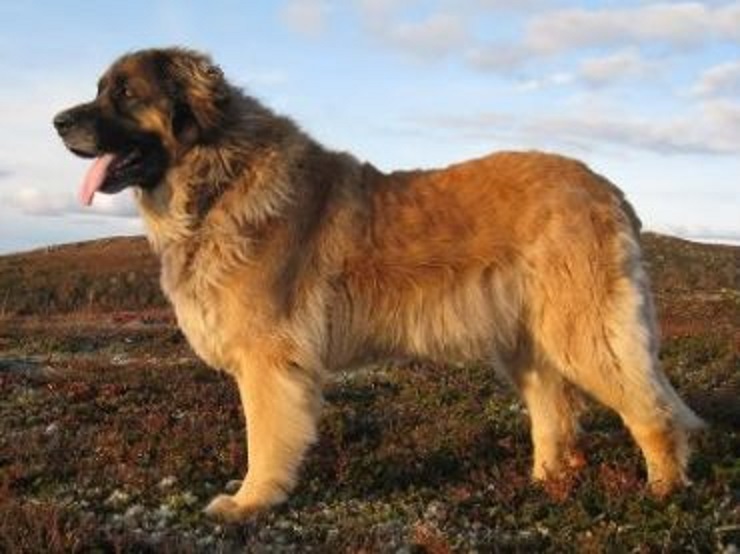
Leonberger

Navigate through the tabs
Navigate through the tabs below to view the breed's info of your interest.
The breed's info is divided in four sections; namely:
the breed's history ,
the breed's main stats ,
the dog's potential health issues
and finally, how the breed scored in 26 different categories.
All the above information should give you a respectively good overview for the dog of your interest.
Dog Breed's Main Info
The Breed's History:
In the 1830s, Heinrich Essig, a dog breeder and seller and mayor of the town of Leonberg near Stuttgart in Baden-Wurttemberg, Germany, claimed to have created the Leonberger by crossing a female Landseer Newfoundland with a "barry" male from the Great St. Bernard Hospice and Monastery (which would later create the Saint Bernard breed).
Later, according to Essig, a Pyrenean Mountain Dog was added, resulting in very large dogs with the long white coats that were the fashion for the time, and pleasant temperament. The first dogs registered as Leonbergers were born in 1846 and had many of the prized qualities of the breeds from which they were derived.
The popular legend is that it was bred to resemble the coat-of-arms animal of Leonberg, the lion.
The Leonberger dog became popular with several European royal households, including Napoleon II, Empress Elizabeth of Austria-Hungary, the Prince of Wales, Otto Von Bismarck, Emperor Napoleon III and Umberto I of Italy. Essig's claim of breeding the dog as described is disputed.
At least as early as 1585, the royal household of Austrian Prince Franz Metternich, of Wolfberg, father of Prince Metternich, owned dogs of the same description.
Either way, there is no doubt that Essig named and registered the breed first. A black and white engraving of the Leonberger was included in "The Illustrated Book of the Dog" by Vero Shaw (at p. 488) in 1881.
At the time, Essig's Leonbergers were denounced as an indifferent knockoff of a St. Bernard, not a stable and recognized breed, and a product of a popular fad or fashion for large and strong dogs, fomented in part by Essig's prodigious marketing skills (he gave dogs to the rich and famous).
The modern look of the Leonberger, with darker coats and a black masks, was developed during the latter part of the 20th century by re-introducing other breeds, such as the Newfoundland. This was necessary because breeding stocks of the leonberger were seriously affected by the two world wars. During World War I most Leonbergers were left to fend for themselves as breeders fled or were killed.
Reportedly, only five Leonbergers survived World War I and were bred until World War II when, again, almost all Leonbergers were lost. During the two world wars, Leonbergers were used to pull the ammunition carts, a service to the breed's country that resulted in the Leonbergers' near-destruction. Leonbergers today can have their ancestry traced to the eight dogs that survived World War II.
Traditionally, Leonbergers were kept as farm dogs and were much praised for their abilities in watch and draft work. They were frequently seen pulling carts around the villages of Bavaria and surrounding districts.
Around the beginning of the 20th Century, Leonbergers were imported by the Government of Canada for use as water rescue/lifesaving dogs.
The breed continues in that role today, along with the Newfoundland, Labrador Retriever and Golden Retriever dogs; they are used at the Italian School of Canine Lifeguard.
The Leonberger received American Kennel Club recognition as a member of the Working Group on January 1, 2010, alongside the Icelandic Sheepdog and the Cane Corso. It was the 167th breed to be recognized by the AKC.
Country of Origin:
Germany
Breed Group:
Working
Height:
2 feet, 1 inch. to 2 feet, 7 inch. (63,5 to 78,74 cm)
Weight:
120 to 170 pounds (54,43 to 77,12 Kg)
Life Span:
10 to 12 years
Potential Health Issues:
Heart Problems,
Hip Dysplasia,
Inherited Leonberger Paralysis/Polyneuropathy (ILPN),
Osteosarcoma,
Hemangiosarcoma,
Osteochondrosis Dissecans,
Allergies,
Digestive Disorders,
Cataracts,
Entropion/Ectropion Eyelids,
Progressive Retinal Atrophy (PRA),
Thyroid Disorders,
Perianal Fistulas
Adaptability
Apartment Living:
First Time Owners:
Sensitivity:
Being Alone:
Cold Weather:
Hot Weather:
Friendliness
Affection With Family:
With Kids:
With Dogs:
With Strangers:
Health and Grooming
Shedding:
Drooling:
Easy To Groom:
Overall Health:
Weight Gain Potential:
Size:
Training
Easiness:
Intelligence:
Mouthiness:
Prey Drive:
Barking or Howling:
Wanderlust:
Need For Exercise
Energy Level:
Intensity:
Exercise Needs:
Playfulness:
Our Mobile Application
Check out Our Mobile Application "Dog Breeds Central"
